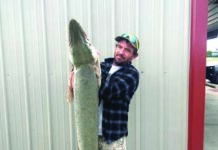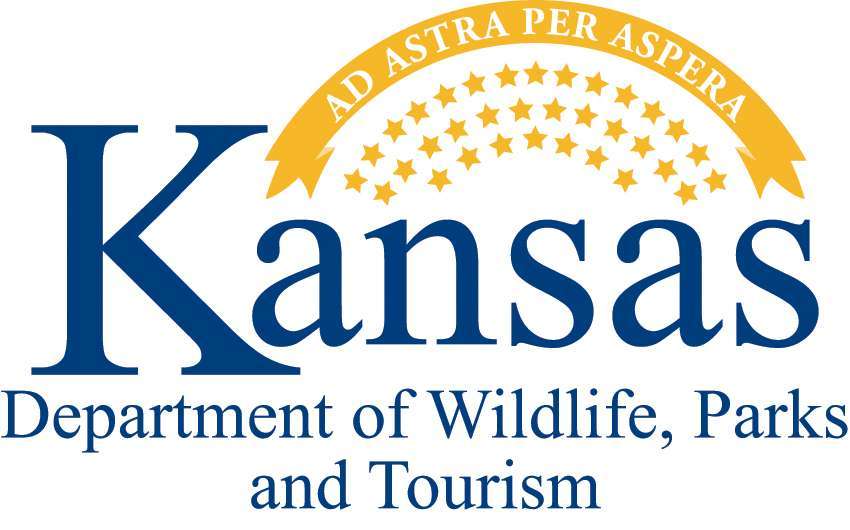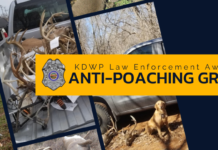PRATT – In March, Kansas Department of Wildlife, Parks and Tourism (KDWPT) fisheries biologists and other staff collected nearly 100 million walleye eggs.
Thanks to the Kansas Walleye Initiative, a record percentage of the walleye and saugeye hatched from those eggs will likely end up on the hooks of Kansas anglers.
“We’ve been having some great success, and the program is only four or five years old,” said Scott Waters, KDWPT fisheries biologist and chairman of the walleye committee. “It’s already leading to more catchable walleye.”
The program began in 2015, with meetings between fisheries biologists and a variety of researchers and hatchery staff. Waters was also quick to thank the Kansas Wildlife, Parks and Tourism Commission for ongoing support for the program.
The initiative has led to the following:
Higher survival rate for stocked fingerlings
One of the program’s goals is to increase the size of stocked walleye fingerlings from about 1.25 inches to 1.7 inches, giving fingerlings a chance to develop scales before being stocked and a better chance of survival. The increased size makes it easier for them to find food, and scales protect against fatal infections.
Bigger and better walleye for stocking
The Kansas Walleye Initiative has led to hatcheries implementing an intensive walleye culture process that has increased production of “intermediate” walleyes that are 8 to 10 inches long when stocked. These fish are stocked in the fall, have very high survival rates and are well on their way to being of a desirable size for anglers. Last year, about 20,000 intermediates were produced and stocked in Kansas lakes and reservoirs. Waters said the department’s goal of producing 75,000 intermediate-sized walleye is within sight.
Specialized management plans
Largely depending on their capabilities, reservoirs and lakes are now classified and managed in four categories:
Harvest lakes are managed to allow anglers to harvest walleye or saugeye and have a 15-inch minimum length limit.
Trophy waters are managed to give anglers their best chance at a walleye or saugeye of trophy-sized proportions, using 18- or 21-inch minimum length limits and sometimes reduced creel limits.
Brood walleye lakes are managed to provide good fishing yet a ready supply of healthy walleye eggs for the program.
Biological control lakes are managed to keep good numbers of big walleye and saugeye in the water to help control problematic species, like white perch.
Waters said the plan is to keep at least one lake from each category within an easy drive of most Kansas anglers.
Stocking based on priority and potential
Kansas reservoirs and lakes are now more closely studied and ranked based on walleye or saugeye need and potential. Rather than randomly distributing fish for stocking, fry, fingerlings and intermediates are sent to where they’re most needed, yet likely to survive and thrive.
Funding the project
The Kansas Walleye Initiative’s goals are becoming realities because of significant funding improvement for the state’s walleye hatchery program. High on that list is a $2 million specialized walleye facility being constructed at the Meade Fish Hatchery. Another $225,000 has been spent to improve specialized equipment at the department’s Milford Fish Hatchery. There’s also an annual budget of $280,000 to cover the enhanced feed and energy costs, plus the purchase of fingerlings from private fish producers when needed.
Two full-time employees have been hired specifically for the program and funding to hire part-time employees, when needed, is also available.
Waters said the majority of the funding comes from fishing license revenue and the Dingell-Johnson fund, derived by federal excise taxes placed on fishing gear. D-J grants can only be used on projects that improve fishing and require 25 percent matches, provided by license revenue.
“As usual, everything goes back to the anglers really being the ones who pay for projects,” said Waters. “We should get a really good return on the investment. We see an excellent future.”
###
Increased Pressure on Public Waterfowl Hunting Areas Discussed at Wildlife, Parks and Tourism Commission Meeting
PRATT –At the March 25, 2021 public meeting, Kansas Wildlife, Parks and Tourism Commissioners discussed issues raised by Kansas waterfowl hunters about the increase in nonresident waterfowl hunters during the 2020-2021 season. At the request of commissioners, Tom Bidrowski, Kansas Department of Wildlife, Parks and Tourism (KDWPT) migratory gamebird program manager, presented data on the number of resident versus nonresident hunters on public waterfowl hunting areas. According to Kansas Duck State Waterfowl Permit sales, non-residents made up 38 percent of Kansas waterfowl hunters last season – up from 21 percent in 2011. However, that ratio varies, depending on the wildlife area.
Several commissioners pushed for a solution to the problem before the upcoming season. Possible solutions discussed include limiting the number of days non-residents can hunt waterfowl at some Kansas public areas and/or limiting the number of non-residents on such areas via a lottery drawing. The topic will see more discussion at the commission’s April 29 meeting.
Other items of note addressed during the March 25 meeting:
Season dates, limits for 2021-2022 waterfowl seasons.
Bidrowoski presented proposed season dates and limits for upcoming duck and goose seasons. The proposed dates and limits follow a similar framework of recent seasons and go to a vote at the April 29 meeting.
An exception could be the weekend before regular duck seasons open, when youth, people with disabilities, veterans and active military are allowed to hunt.
Commissioners discussed changes that could reduce conflicts and ensure youth experience high-quality hunts.
Increased opportunities for youth, parents
KDWPT staff and commissioners continued discussion about raising the maximum age of youth participating in youth seasons to 17. Currently, the maximum age is 16 for pheasant, quail, turkey and deer youth seasons, but 15 for waterfowl youth seasons. The change being considered is meant to increase opportunity and make regulations consistent.
Another recommendation will remove the requirement that adults accompanying youth hunters during the youth waterfowl season be licensed and have appropriate stamps. Again, the goal is to increase opportunities for youth and simplify regulations.
Jeff Prendergast, KDWPT small game specialist, recommended allowing youth hunters to take full bag limits of pheasant (four roosters per day) and quail (eight per day) during the youth weekend. Currently, youth season daily bag limits are half those allowed during the regular pheasant and quail seasons.
Continuous prairie chicken season
Kent Fricke, KDWPT small game program coordinator, presented staff recommendations to run the 2021-22 greater prairie chicken season from Sept. 15 through Jan. 31. Previously, the season has ran from Sept. 15 through Oct. 15, and the third Saturday of November through Jan. 31.
The early season segment, when hunters typically hunt greater prairie chickens with dogs, has gained in popularity and this change would increase those opportunities. Research shows hunters annually harvest no more than 3 percent of the Kansas greater prairie chicken population, so eliminating the split is not expected to have any impact on prairie chicken populations. Fricke said northcentral Kansas, where greater prairie chicken numbers remain strong, receives the most hunting pressure.
State park kiosks
Linda Lanterman, KDWPT Parks Division director, updated the commission on the plans to install electronic kiosks in designated Kansas state parks this year. The kiosks will allow park users to purchase permits with credit cards, replacing the cumbersome and inefficient unmanned “Iron Rangers,” which require cash deposits. The kiosks will provide users a receipt that can be placed on the dash of their vehicle.
Improving commission/public communications
Nadia Reimer, KDWPT chief of Public Affairs, presented plans to improve communications between the public, commissioners and department staff by creating a central webpage for that purpose. The new page will provide a place for the public to submit questions, ensure that all public questions are answered and make it easier for the public to request topics for discussion at future commission meetings.
Pronghorn permit reduction
Citing several years of poor reproduction, Matt Peek, KDWPT wildlife research biologist, indicated a 20 percent reduction in firearm and muzzleloader permit quotas will be recommended for this fall. Peek also mentioned that staff are considering a change for the 2022 application process that would prohibit hunters who purchase an over-the-counter archery permit from also purchasing a firearm preference point. Archery season hunting pressure increased significantly since that option has been allowed.
Big game clothing requirement change
Levi Jaster, KDWPT big game program coordinator, introduced a request to modify the state’s requirement for wearing of “hunter orange” while hunting deer and elk during a firearm season.
The proposal would allow hunters to wear an orange “garment” on their head instead of a hat, as the regulation now requires. The addition would allow the use of garments like thick headbands for those with hairstyles that make wearing traditional caps and hats difficult.
Deer hunting permit numbers
Commissioners voted to approve season dates for 2021-22 deer seasons, which largely resemble recent seasons.
Jaster informed commissioners of quotas set for non-resident deer and resident firearm either-species permits for the 2021 seasons. Overall numbers are similar to 2020, with a modest reduction in permits that allow the taking of a mule deer.
Virtual meeting continuation
Commissioners decided the April 29 commission meeting will be virtual because of COVID-19 concerns. It was originally to be held in-person in Beloit.
Gerald Lauber, commission chairman, praised the success of the current virtual format, which allows the public to participate through Zoom or watch on YouTube.
For more information on future and past commission meetings, visit https://ksoutdoors.com/KDWPT-Info/Commission.
###
You are subscribed to email updates from KDWPT News Update.
To stop receiving these emails, you may unsubscribe now.
Email delivery powered by Google
Wheat Scoop:
April 15 Update on Condition of Kansas Wheat Crop
The Kansas wheat crop is in relatively good shape for this time of year, but there are still a couple months until harvest, and a lot can change over that time.
With recent spring moisture, the crop is rated 16% poor to very poor, 29% fair and 55% good to excellent by USDA’s National Agricultural Statistics Service (NASS) as of April 11.
The crop is about 7-10 days behind average. NASS reported that 29% of the crop is jointed, which is behind 36% for the five-year average.
Fall & Winter Conditions
At the Kansas Association of Wheat Growers (KAWG) board meeting on April 8, farmers from across the state reported that the condition of the wheat crop is variable, depending on planting date, and that most areas are finishing up with fertilizer applications. The earlier planted wheat is in good condition.
“Last fall in September, considerable precipitation allowed early planted wheat to emerge and have very good development during the fall,” said Romulo Lollato, wheat production specialist with Kansas State University. However, he added, “October to mid-November was very dry.”
“The late-planted wheat has been slow to grow and has low tiller counts,” said KAWG President Justin Knopf.
Arctic temperatures in mid-February with extremely cold air temperatures, limited snow cover across the state and overall dry conditions caused some concern about winterkill.
“The promising thing was that the soil temperatures never got to single digit temperatures, and that is where the crown of the wheat was located at that time,” said Lollato. “By late March and early April, we were better able to assess how the crop was faring. The small wheat in March that was later planted is showing some spring tillering and green leaves.
“Right now we’re hopeful that not much area of winter wheat will be lost due to that potential for winterkill from the February cold spell.”
March Precipitation
According to the Kansas State University March 2021 Ag Climate Update, “March was much wetter than normal, ranking as the 5th wettest March since 1895. This resulted in improving drought conditions across the state.
“The moisture, coupled with warmer temperatures, greatly aided winter wheat development.” Read more at http://climate.k-state.edu/ag/updates/.
According to Lollato, this moisture really helped the crop recover from any potential injury it suffered over the winter, helped put fertilizer into the root zone, and is used efficiently by the crop for stem elongation.
“From now until heading is when the crop needs the largest amount of water,” he said.
Watch Lollato’s video update at https://www.youtube.com/watch?v=L_AtfcGum6Y.
Disease Pressure
While the wheat crop is in overall good condition, there are some instances of disease pressure starting to show up. With the dry conditions last fall, a lot of volunteer wheat didn’t get controlled. Instances of Wheat Streak Mosaic Virus are showing up in some unconventional locations, including central Kansas.
“We are seeing a higher number of WSM samples than what we typically see this time of year,” said Kelsey Andersen Onofre, plant pathologist with Kansas State University. “Wheat Streak Mosaic is showing up early this year in western/west central and also central counties – Barton, McPherson and Saline counties. We’re really keeping an eye on that right now.”
Wheat Streak Mosaic Virus is transmitted by the wheat curl mite, which survives on volunteer wheat and other weedy host species and grasses. There is no treatment for WSMV, so the best way to manage it is after harvest by controlling host species.
“Fields that were infected right after emergence are showing bad symptoms of wheat streak mosaic this time of year,” said Onofre. “Those will cause the highest amount of yield loss. Wheat that’s affected later in the season or has some resistance can have less yield loss.”
Listen to Onofre’s interview with Duane Toews at https://kswheat.com/file/wheat041221mp3.
Wheat Tour
The Wheat Quality Council will host its annual Hard Winter Wheat Tour this year on May 17-20. Crop scouts will be evaluating the wheat and calculating potential yields using the NASS formula for this year. Sign up for updates from the tour and harvest reports on our website at https://kswheat.com/harvest.
###
Written by Marsha Boswell, V.P. of Communications, Kansas Wheat





